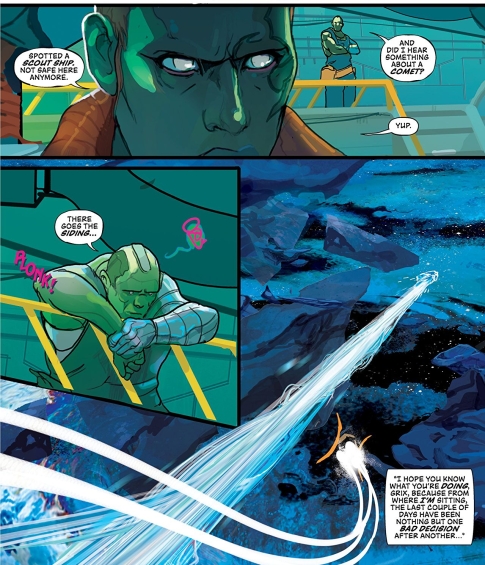by G. Willow Wilson & Christian Ward
collects Invisible Kingdom #1=5
volume reviews one | two
Invisible Kingdom is an imaginative and vibrant science fiction series by G Willow Wilson (Ms. Marvel) and Christian Ward (OY-C). This debut book is very pretty to look at and introduces a few interesting characters, but it’s bogged down by its commentary of our own corruption and consumerism.

Our main protagonists are two women, Grix and Vess, who are on opposing sides of two major powers in their star system. Grix is your standard charismatic and stubborn starship captain, whose ragtag crew helps deliver packages for corporation Lux. Grix accidentally finds an error in Lux’s cargo manifest that’s more than just a typo. Vess is a “none,” a new initiate in the Renunciation, a cult like religion with an all powerful leader with a particular interest in Vess. Vess similarly finds that her calling isn’t all what it seems to be, and the two eventually find each other.
It’s refreshing to see Wilson writing a completely different kind of story than Ms Marvel, and Vess and Grix are interesting characters. I’ll never complain about two women leading a sci-fi story, even if they aren’t particularly against type in science fiction – Grix is basically Mal Reynolds from Firefly. Unfortunately there isn’t enough time spent to feel invested in the rest of the crew. I don’t remember any of their names, and Grix’s love interest among them was a reveal I wish I had cared about more.

A strong commentary or satire is a hallmark of good scifi stories, but here it’s distracting and too on the nose to be fully swept up in the story – or any message Wilson might be building to. Lux is clearly Amazon in space, and the Renunciation is Corporatized Big Religion. There’s no mystery or powerful message behind it either, and yet another commentary about the news and information consumerism swoops in at the end making it even more hollow. Between that and some standard sci-fi exposition, the story often feels bogged down by trying to do too much.
If everything covered in this volume had spanned two, Wilson could have focused more on character and let the commentary breathe and build more delicately, rather than hitting us over the head with it.
Christian Ward’s art, colors and lettering pulls everything together when the story is lacking. Even with all its bright colors – including, as one would expect with aliens, a rainbow of skin colors and body shapes – the world still feels grounded in its own reality. It never feels too outlandish, though sometimes the characters seem a bit out of focus. His lettering is also delightful, with the sounds of beeps, distress signals, and swooping ships in motion along with the art. The way Ward structures panels is also creative and dynamic, particularly during the final issue’s space battle.

After Ms Marvel, Wilson became an author whom I would follow without question to her next book. But surprisingly, it’s because of Ward’s art that I’m willing to check out volume two. I hope Wilson gives the next story arc more time to more fully realize her characters and dig deeper into the commentary. It’s an intriguing start.
